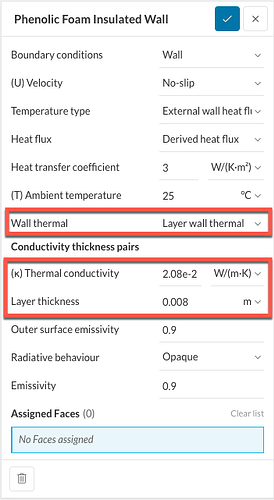U value
U value in building and construction industry refers to the measure of how effective a material can act as an insulator. It is generally used to quantify the insulation capacity of a building fabric. In other words, the degree to which the material can prevent heat from transmitting between the inside and the outside of a building.
Lower the U-value of a material using in a building fabric, the more slowly heat is able to transmit through it and hence performs as a better insulator.
Using SimScale’s Convective or conjugate heat transfer, we can simulate the effect of various building fabrics based on their U-values and their effect on the occupant’s thermal comfort.
Here is an example of how you can apply the U-values as a simulation input:
Let’s take an example of an External wall insulation layer made of Phenolic foam. Specified U value of Phenolic foam can be around 0.26 W/Km^2. To apply this value on a wall within SimScale, we would need the thermal conductivity of the material and thickness of the insulation layer.
Thermal conductivity of the layer can be easily calculated using the thickness of the layer used.
Example calculation:
U-value = 0.26 W/Km^2
Thickness = 0.08 m
Thermal conductivity = U-value * thickness of the insulation layer
= 0.26*0.08
=0.0208 W/Km
Thermal conductivity and thickness can then be applied in a Wall boundary condition within SimScale as shown below:
To know how a wall boundary condition can be used for External building walls and windows, please take a look at our page on " How to Assign Wall and Window Settings for Thermal Comfort Simulations?"
Note: In general, the walls of a building might have more than one layer, hence an effective thermal conductivity and thickness of all the layers involved should be calculated.
To know more about simulating the effect of building fabrics, please take a look at our webinar on " Fabric First: CFD for Passive Environmental Design"
